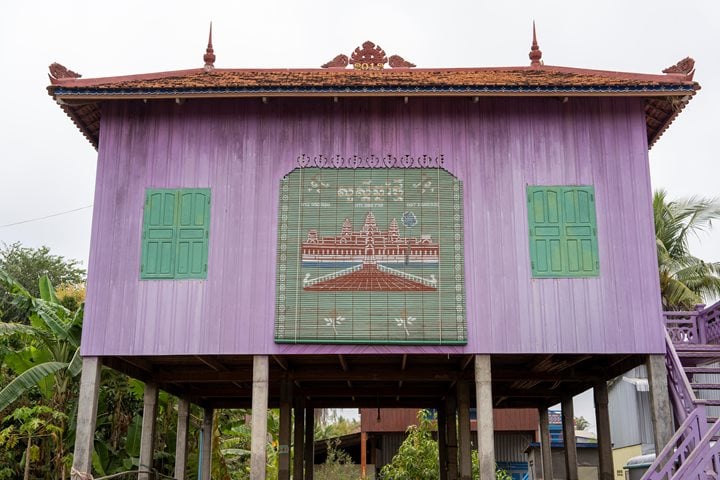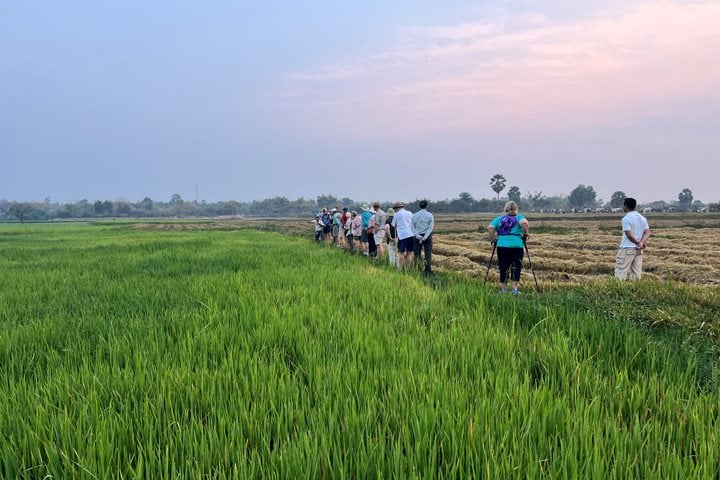Phnom Penh
Phnom Penh beckoned. We’d docked by its riverbank at night, and the blinking lights held promises of a break from the countryside.
In the morning, the excitement was clear at breakfast, as we had been promised a ride on a pedi-cab—a three-wheeled contraption. Getting on was fun and we realized it was like sitting in a mobile armchair with a friendly driver pedaling behind us, pushing us forward into the energetic streets of Cambodia’s capital city.
Some twenty minutes later, we arrived at a plaza in front of the expansive Royal Palace. “That was fun,” someone said. “Fantastic!” came the reply.
We could visit the palace freely, as King Sihamoni was not in residence. He had accompanied his father, Norodom Sihanouk, on a customary medical visit to Beijing. The old king, though often ill and now 90 years old, remains feisty even if his life has been a rollercoaster ride through an eventful history.
The tropical sun was beating down on us, but the tour members gamely walked the grounds, marveling at the golden roofs, the murals, the grandeur of it all. Then it was the Silver Pagoda, full of artifacts and Buddha statues of all sizes and postures.
There were more statues of ancient kings and Buddha at the National Museum, a striking red building high off the ground. It is imposing and yet inviting at the same time: an open and airy space, with halls set around a large courtyard with cooling palms and greeneries. We spent an hour absorbing more history and seeing red and brown stone sculptures, somehow more revealing in isolation than in their original settings in the temples around the Angkor complex.
Tapas seemed an odd if original choice for lunch—until we realized it was in fact a visit to the august Topaz Restaurant. “Only for VIPs,” said Sam, our guide. No Spanish food, but a traditional dish called Fish Amok, tasty, slightly spicy, and definitely presented with elegant style in an artfully folded banana leaf.
Then it was time for a visit we all knew would be difficult but important and necessary: The Killing Fields and then S-21, code name for Tuol Sleng. Four buildings that had been a school until the Khmer Rouge turned it into a prison, S-21 was a torture center—and now is a devastating museum. It is here that one comes to gain some true sense of the madness, the enormity of the cruelty that had descended upon the Cambodian people. Each of the people that had been brought here were methodically photographed, then tied to iron beds, tortured, interrogated, made to write impossible confessions, and left to die, or executed not far away. An estimated 17,000 people suffered this unspeakable fate, and it drained us to walk past the brick walls that had held them, and to look into their eyes: portrait after portrait, lined up in rows and rows of photographs. A visit to Tuol Sleng makes you question humankind; it drains you, and it changes you.
After that, an energetic lecture aboard the Jahan by the eloquent and unbelievably knowledgeable journalist and scholar Jean-Michel Filippi was an apt ending for the day. His hour-long presentation traced events in Cambodia since it gained independence from France in 1953, to 1993 when the United Nations successfully organized the first mass elections in this battered country. It was like reading an encyclopedia on the personalities, the historical contexts, and the wars and sick aims of sick men that destroyed a nation in a few years.
Later, the devastation we all felt was temporarily and mercifully erased with a performance by profoundly graceful traditional dancers and musicians. It was obvious the extreme beauty—and the severe ugliness of the recent history—will remain inside each of us long after this Cambodian journey has come to an end.






